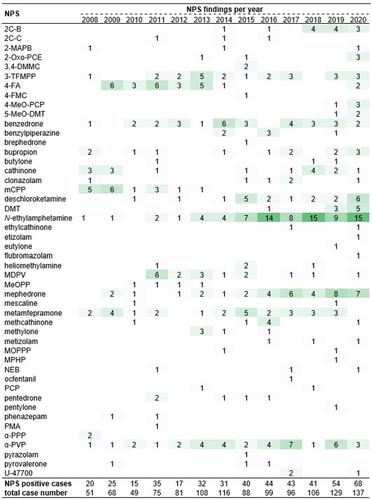当前位置:
X-MOL 学术
›
Drug Test. Anal.
›
论文详情
Our official English website, www.x-mol.net, welcomes your feedback! (Note: you will need to create a separate account there.)
Prevalence and concentrations of new designer stimulants, synthetic opioids, benzodiazepines, and hallucinogens in postmortem hair samples: A 13-year retrospective study
Drug Testing and Analysis ( IF 2.9 ) Pub Date : 2021-08-26 , DOI: 10.1002/dta.3150 André Niebel 1, 2 , Lena Westendorf 1 , Franziska Krumbiegel 1 , Sven Hartwig 1 , Maria Kristina Parr 2 , Michael Tsokos 1
Drug Testing and Analysis ( IF 2.9 ) Pub Date : 2021-08-26 , DOI: 10.1002/dta.3150 André Niebel 1, 2 , Lena Westendorf 1 , Franziska Krumbiegel 1 , Sven Hartwig 1 , Maria Kristina Parr 2 , Michael Tsokos 1
Affiliation

|
Hair samples are frequently analyzed in order to characterize consumption patterns of drugs. However, the interpretation of new psychoactive substance (NPS) findings in hair remains difficult because of lacking data for comparison. In this study, selected postmortem hair samples (n = 1203) from 2008 to 2020 were reanalyzed for synthetic cathinones, piperazines, phenethylamines, hallucinogens, benzodiazepines and opioids to evaluate prevalence data and concentration ranges. Hair samples were extracted using a two-step extraction procedure and analyzed using a validated liquid chromatography–tandem mass spectrometry (LC–MS/MS) method. Overall NPSs were detected in 381 cases (31.6%). Many cases were tested positive for more than one NPS in the same time span. A variety of NPS with a large range of concentrations was observed. For better comparability and interpretation of positive cases in routine work, quantitation data for 13 NPS were calculated as percentiles. The most frequently detected NPS in this study were N-ethylamphetamine, α-pyrrolidinovalerophenone, mephedrone, benzedrone, metamfepramone, and 4-fluoroamphetamine. In conclusion, a high prevalence of these drugs was observed from postmortem hair samples. The results show a growing use of many different NPSs by mainly young drug-using adults. Consequently, NPS screening procedures should be included in forensic toxicology. Our quantitative data may support other toxicologists in their assessment of NPS hair concentrations.
中文翻译:

死后头发样本中新设计师兴奋剂、合成阿片类药物、苯二氮卓类药物和致幻剂的流行和浓度:一项为期 13 年的回顾性研究
头发样本经常被分析以表征药物的消费模式。然而,由于缺乏比较数据,对头发中新的精神活性物质 (NPS) 发现的解释仍然很困难。在这项研究中,选定的死后头发样本(n = 1203) 从 2008 年到 2020 年,对合成卡西酮、哌嗪、苯乙胺、致幻剂、苯二氮卓类药物和阿片类药物进行了重新分析,以评估流行数据和浓度范围。使用两步提取程序提取头发样品,并使用经过验证的液相色谱-串联质谱 (LC-MS/MS) 方法进行分析。在 381 例 (31.6%) 中检测到总体 NPS。许多病例在同一时间跨度内检测出不止一种 NPS 呈阳性。观察到各种浓度范围较大的 NPS。为了在日常工作中更好地比较和解释阳性病例,13 种 NPS 的定量数据以百分位数计算。本研究中最常检测到的 NPS 是N-乙基苯丙胺、α-吡咯烷戊烯酮、甲氧麻黄酮、苯甲酮、甲基苯丙胺和 4-氟苯丙胺。总之,从死后的头发样本中观察到这些药物的高流行率。结果显示,主要是年轻的吸毒成年人越来越多地使用许多不同的 NPS。因此,NPS 筛选程序应包括在法医毒理学中。我们的定量数据可能支持其他毒理学家评估 NPS 头发浓度。
更新日期:2021-08-26
中文翻译:

死后头发样本中新设计师兴奋剂、合成阿片类药物、苯二氮卓类药物和致幻剂的流行和浓度:一项为期 13 年的回顾性研究
头发样本经常被分析以表征药物的消费模式。然而,由于缺乏比较数据,对头发中新的精神活性物质 (NPS) 发现的解释仍然很困难。在这项研究中,选定的死后头发样本(n = 1203) 从 2008 年到 2020 年,对合成卡西酮、哌嗪、苯乙胺、致幻剂、苯二氮卓类药物和阿片类药物进行了重新分析,以评估流行数据和浓度范围。使用两步提取程序提取头发样品,并使用经过验证的液相色谱-串联质谱 (LC-MS/MS) 方法进行分析。在 381 例 (31.6%) 中检测到总体 NPS。许多病例在同一时间跨度内检测出不止一种 NPS 呈阳性。观察到各种浓度范围较大的 NPS。为了在日常工作中更好地比较和解释阳性病例,13 种 NPS 的定量数据以百分位数计算。本研究中最常检测到的 NPS 是N-乙基苯丙胺、α-吡咯烷戊烯酮、甲氧麻黄酮、苯甲酮、甲基苯丙胺和 4-氟苯丙胺。总之,从死后的头发样本中观察到这些药物的高流行率。结果显示,主要是年轻的吸毒成年人越来越多地使用许多不同的 NPS。因此,NPS 筛选程序应包括在法医毒理学中。我们的定量数据可能支持其他毒理学家评估 NPS 头发浓度。



























 京公网安备 11010802027423号
京公网安备 11010802027423号